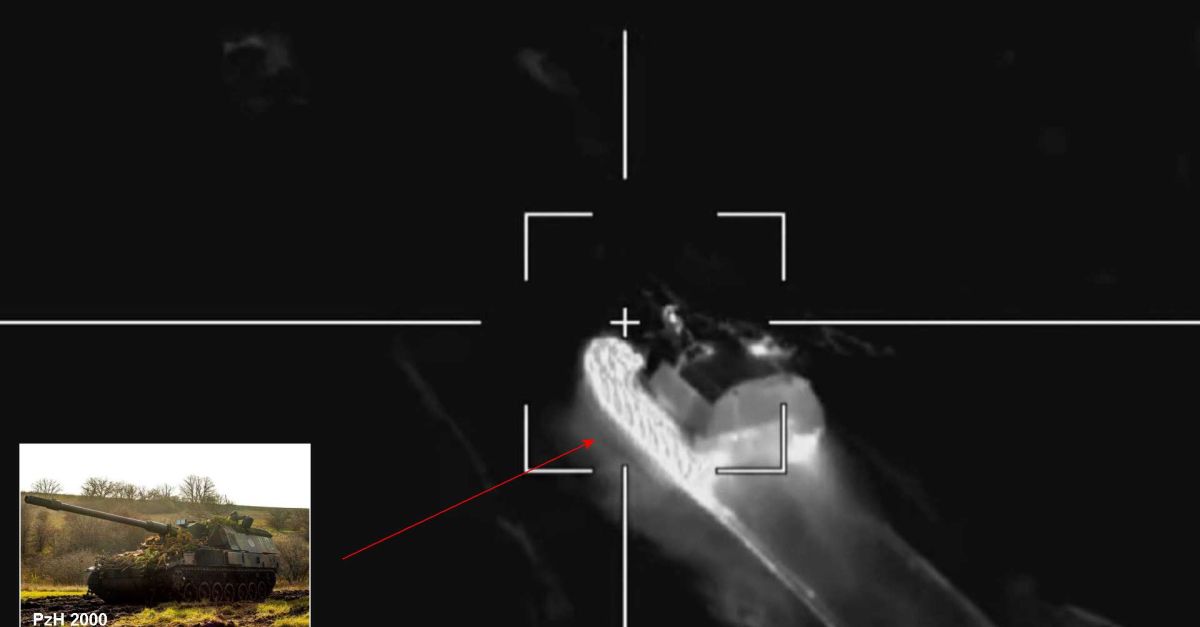Breaking news
Russia Prioritizes Destruction of US and European Combat Vehicles Targeting Another Ukrainian PzH 2000 Howitzer.
Russian Lancet drone has successfully damaged a German PzH 2000 artillery system. The incident, captured on video and posted on the social media platform Telegram on May 17, 2024, underscores the priority of Russian forces to target and destroy modern military equipment received by Ukraine from European and US allies.
Follow Army Recognition on Google News at this link

Video of the Lancet drone attack on a Ukrainian PzH 2000 155mm tracked self-propelled howitzer donated by Germany and Italy. (Picture source: video footage Telegram)
According to the video, the crew of the PzH 2000 howitzer abandoned the vehicle, which appears not to have been completely destroyed. This could be an opportunity for the troops to capture the most modern German-made artillery system for the first time.
The attack of the German-made PzH 2000 artillery howitzer is not an isolated event but part of a strategic approach by the Russian military. This approach specifically targets modern combat vehicles and equipment supplied to Ukraine by European countries and the United States, with the aim of neutralizing these advanced systems and shifting the balance of power in the conflict.
The PzH 2000, a state-of-the-art German self-propelled howitzer, offers significant advantages over the older Soviet-made 2S1 and 2S3 artillery systems still in service with the Ukrainian army. Compared to the 2S1 and 2S3, the PzH 2000 boasts a superior range, firing up to 40 kilometers with standard ammunition and even more with specialized rounds. In contrast, the 2S1 and 2S3 typically have a maximum range of around 15 to 18 kilometers. Additionally, the PzH 2000 features a much faster rate of fire, capable of delivering multiple rounds in rapid succession thanks to its advanced autoloader. In contrast, the 2S1 and 2S3 rely on slower, manual loading mechanisms. The PzH 2000 also benefits from modern targeting systems and enhanced mobility, providing better accuracy and the ability to quickly reposition on the battlefield, thus offering a substantial upgrade in offensive and defensive capabilities for the Ukrainian forces.
The Russian armed forces have increasingly relied on loitering munitions, such as the Lancet drone, to carry out precision strikes on high-value targets. These drones can hover over an area for extended periods before engaging their targets, making them a formidable tool in the Russian military's arsenal.
The Lancet drone, employed by Russian troops in Ukraine, serves as a highly effective loitering munition designed for precision strikes on high-value targets. These drones can hover over an area for extended periods before engaging, allowing them to effectively destroy modern military equipment supplied to Ukraine by European and US allies. The Lancet's use highlights Russia's focus on neutralizing advanced Western-supplied weaponry to diminish Ukraine's defensive and offensive capabilities, contributing to the evolving landscape of technological warfare in the conflict.
The Lancet-3 drone is a loitering munition developed by Russia, featuring a compact and lightweight design with a wingspan of approximately 1.2 meters and a weight of around 12 kilograms. It is equipped with an electro-optical system for target acquisition and guidance, providing high-precision strikes. The drone has an operational range of up to 40 kilometers and can hover over targets for an extended period before striking. Its payload includes a high-explosive fragmentation charge weighing about 3 kilograms, designed to destroy armored vehicles and other high-value targets, making it a versatile and effective weapon in modern warfare.
By focusing on destroying European and American equipment, Russia aims to deplete Ukraine's modern military resources, forcing it to rely on older, less effective systems. This strategy is intended to weaken Ukraine's defensive and offensive capabilities, thereby altering the balance of power in the conflict.
The ongoing conflict in Ukraine has seen a steady influx of military aid from Western nations, with advanced weapons systems playing a crucial role in the country's defense strategy. The recent incident involving the Lancet drone serves as a stark reminder of the escalating technological warfare and the challenges faced by Ukrainian forces in countering Russian advances.




























